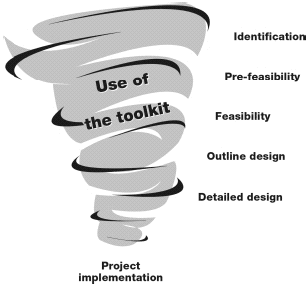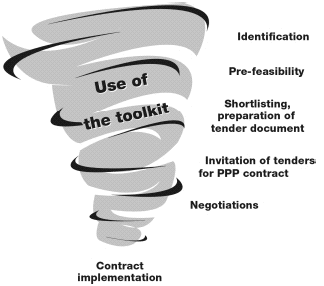Water Prices in CEE and CIS Countries. Volume I: Main Text
Chapter 2
The Toolkit and the Planning Process
2.1 Introduction
The purpose of this chapter is to provide guidance as to how to use the toolkit to deal with the interlinkages between the supply side and the demand side for water services. The supply of water services is a function of the current technical profile and operations, the service level targets and the resulting cost and expenditure, whereas the demand for water services is a function of customer perception, willingness to pay and affordability. Political acceptability may influence tariffs and their collection.
The target group for this chapter is all readers of the toolkit (or parts hereof).
The toolkit is intended for use i relation to both traditional investment projects and with the establishment of a public-private partnership within the water services sector. Some tools are to be used in the pre-feasibility phase, and other tools are to be used in a later phase of the project planning cycle.
When describing the project cycle, we distinguish between traditional investment projects and PPP projects. The two cycles are very similar in the project identification and pre-feasibility stages, but differ thereafter. The timing of the use of the toolkit for a traditional investment project is illustrated in Figure 2.1 and Figure 2.3. The timing of the use of the toolkit for a public-private partnership project is illustrated in Figure 2.2 and Figure 2.3.
As indicated in the previous chapter, the determination of the appropriate future service level and thus the needed investment and operational characteristics ought to be an iterative process, where technical and cost considerations are matched against the prospective customer demand for services. For each step, these considerations are, at the same time, narrowed to deal with fewer options and expanded to increase the accuracy and detail of the analysis. It is thus, at the same time, a funnelling and iterative process that takes place.
The characteristics of the first step (project identification) is similar in the traditional investment project and the PPP situation. Project identification takes place in response to an acknowledged problem (such as a polluted river) or a regulatory requirement (such as national implementation of the EU water framework directive). At this stage, the initial ideas about the solution and the service level are formed. These ideas may focus on technical and financial issues, or they may include consideration of a new institutional set up such as a public-private partnership.
2.2 The project cycle and a traditional investment projectThe next step (the pre-feasibility stage) should include an initial assessment of the institutional and regulatory framework, the financial envelope (which in turn depends on water utility revenues and thus on consumer demand) and the technical options. This stage defines what specific issues need further exploration during the following stage, and defines how these issues should be explored. For a traditional investment project this may, for example, be reflected in the terms of reference for a feasibility study.

Figure 2.1:
Project cycle and timing of the use of the toolkit for a traditional
investment project
During the feasibility stage, the assessments defined by the pre-feasibility stage will be undertaken. In most cases, it will be relevant to undertake the demand analysis for which tools are presented in this toolkit. The demand analysis can only be omitted if there are no technical and service level alternatives (and thus no cost alternatives) and if the demand is not sensitive to price. The scope and detail of the demand analysis to be undertaken will, among other issues, depend on the size of the investment, the sensitivity of demand and the autonomy of the water utility. In the following chapters, we provide advice on the suggested scope, approach, timing and resources required depending on the circumstances.
The feasibility stage ends with a feasibility report, which suggests one (or a couple of) approach(es) to the institutional, legal and organisational set up of the project (and utility, if relevant), the technical solution (and the consequent expenditure profile), the future tariff policies (and the consequent expected tariff revenue profile) and project funding.
For a traditional investment project the last steps will be outline design, detailed design, and then project implementation.
2.3 The project cycle and a public-private partnership (PPP) arrangement
The project identification (and to a large degree the pre-feasibility) stages are similar for a traditional investment project and a PPP arrangement.
Also in the case of a PPP arrangement, the pre-feasibility phase should include an initial assessment of the institutional and regulatory framework, the financial envelope (which in turn depends on water utility revenues and thus on consumer demand) and the technical options. When a PPP arrangement is aimed for, the pre-feasibility stage will define which studies need to be carried out in order to become part of the material to be provided to the bidders for a lease, concession or whatever form of private participation is foreseen.
The next steps in the case of a public-private partnership are the identification of a potential partner through shortlisting and the preparation of bidding material. This material should include detailed information on the current infrastructure of the water and wastewater system, the service provided (both as perceived by the customers and "objective" parameters), the legal regulations and the institutional set-up pertinent for the utility, detailed financial information as well as a good description of the demand for water and wastewater services. The latter is done using the present toolkit. The use of the toolkit for the pre-feasibility and the shortlisting and preparation of bidding material stages is illustrated in Figure 2.2.
The private partner will want to reduce his revenue risk. There are many ways of doing this. One of the best ways is to have a reliable and comprehensive assessment of future demand and revenues. The existence of a proper demand analysis which has been prepared using the principles of the toolkit can be instrumental in providing such an assessment. Of course, there are other ways for the private partner to reduce his risk. However, many of these, for example "take-or-pay" agreements, just transfer the revenue risk to the public partner, whereas a good demand analysis and resulting changes in the project design lower the revenue risk.

Figure 2.2:
Project cycle and timing of the use of the toolkit for a public-private
partnership (PPP) arrangement
The PPP negotiation process and contract signature includes, among other things, a formal simultaneous agreement on a number of issues including, but not limited to, service level targets, on the one hand, and payments and tariffs, on the other hand. This process has a greater chance of successful completion the more issues that bear on risk have been dealt with in the previous steps.
2.4 The toolkit in the project cycle - Overview and timingThe suggested timing of the use of each of the tools is discussed in the chapters presenting the tools. Figure 2.3 presents an overview of each of the main tasks for which tools are provided in this kit as well as the suggested timing.
Figure 2.3:
Overview of the toolkit tasks and their timing
The iterative nature of the process has been indicated by illustrating that the service targets and their costs are re-assessed twice. First, following the initial qualitative willingness to pay analysis and the initial policy analysis. Then the targets are re-assessed following the quantitative willingness to pay analysis. In a traditional investment project, these two assessments take place in the pre-feasibility and the feasibility phase, respectively. In the case of a PPP arrangement, the first re-assessment of future service targets takes place in the pre-feasibility phase. In some cases there may be a further reassessment as part of the bidding and negotiation process.